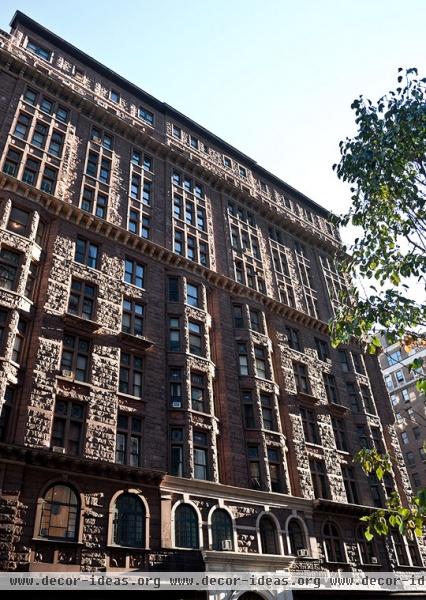Remodeled New York Apartment

Remodeled New York Apartment
Design:
Architect: Brian Connolly, Zivkovic Connolly Architects, PC, 511 W. 25th St., New York, NY 10001; 212/807-8577, zivarch.com.
Interior designer: Marcy Masterson, Marcy V. Masterson Inc. Interior Design, 140 W. 57th St., New York, NY 10019; 212/541-6076, marcymasterson.com.
Text by Candace Ord Manroe
Photographs by Bruce Buck
Fortress-like with its Romanesque-meets-Renaissance facade, the Osborne Building commands a special place in Manhattan's history. It was built in 1883, catty-corner from Car-negie Hall, as one of the city's first apartment buildings expressly designed for "luxury living." Musicians, writers, and artists seeking posh digs in the cultural heart of Manhattan have flocked there ever since. (The tight-security lobby alone is an allure with Tiffany glass, August Saint-Gaudens sculpture, John La Farge murals, and interior detailing by designer Jacob Adolphus Holzer.) One apartment owner, Alison Macheras, is the latest in her family's line of literati to call the Osborne home. She inherited the apartment from her art-collecting grandmother, Hallie Carr Fox, who moved there after marrying her second husband, Lorenzo Alvary, a basso who spent 30 years of his career with the Metropolitan Opera.
"After my grandfather died in 1958, my grandmother traveled to Europe, where she met Mr. Alvary. She brought him home to La Porte, Indiana, to perform concerts. In 1960, they married, and she moved to New York to live with Lorenzo in the Osborne. Over the years, after my father died, both of my sisters, my mother, and I lived at various times with them in this apartment," explains Alison. "I have an enormous attachment to this place."
Not only did she inherit the apartment, she also inherited its contents. Everything needed refreshing. She hired Zivkovic Connolly Architects and interior designer Marcy Masterson to bring spaces back to the full-throated resonance she remembers from her childhood, when Lorenzo would practice vocals in the paneled den and her grandmother would debate where to place a Picasso.
"It was a matter of paring down and then stripping and re-covering everything. I saw no reason to go messing with what wasn't broken," Alison says. Her designer agreed. "It was about refreshing this apartment to Old World splendor and making it a happy, sunny place," Masterson explains. "No one had lived here for years, and nothing had been changed. It was quite dark."
But like every apartment in the Osborne, it had dazzling potential. "The greatest architectural asset," asserts Masterson, "was the flooring. It was this magnificent marquetry, different in each room."
Restoring the floors was one of lead architect Brian Connolly's first projects. "The most spectacular floor is in the entry. It had been covered with a thickly padded carpet for so many years that even Alison had forgotten what was underneath," he says. Replicating each damaged piece of wood was like working a tedious jigsaw puzzle, but with such stunning results even the designer insisted on leaving it bare.
Ceilings, dark since the 1960s, "ruined the perception of the proportions of rooms, not to mention that they substantially darkened things," recalls Connolly. Painted white, "they once again soared," he says. All of the original plaster crown moldings were returned to their 1883 condition, repaired or replaced as necessary. "The only ceiling height to change was that in the hallways, where it was low. When we opened it up, we found the original moldings," the architect explains. He coffered the ceiling to hide ductwork.
"The change in the foyer is probably the most dramatic. It went from being dark and cryptic to warm and inviting," Connolly reflects.
Part of that warmth emanates from colors on the Venetian plaster walls. "In selecting paint, our first and foremost goal was to set off these magnificent floors," notes Masterson. "The entry's warm terra-cotta walls just glow with the marquetry of the gorgeous oak floor." Sunny yellow beckons from the living room and a warmer gold colors walls in the family room--Alison's favorite space. "This was where we lived growing up." New shelving increases livability. "It's the room that reaches out and puts its arms around you," says Alison.
Re-covering heirloom furniture wasn't always easy. "I wasn't sure how we would ever get the pair of 11-foot-long sofas out of the living room," illustrates Masterson, who subdued their scale with a subtle Claremont tone-on-tone weave. "Then I pulled orange from the paintings onto the beechwood bergères."
Those paintings with a splash of orange include a Matisse above the living room fireplace and a Bernard Doufour above the sofa, both bought by Alison's grandmother prior to her marriage to Mr. Alvary.
"After my grandfather died, the chauffeur drove my grandmother, who was born in 1900, from Indiana to the Art Institute in Chicago to take classes. She studied Chinese painting, among other things, and developed her eye for art," Alison says. A portrait of Lorenzo in opera regalia hangs prominently within a niche in new cabinetry created by Connolly for Alison to display her Chinese figurines.
Wanting to honor her grandmother, Alison insisted that the new living room draperies feature a valance identical to the old. "Given this incredibly grand space and its Italian furniture, it was only fitting to put Fortuny at the windows," says Masterson.












